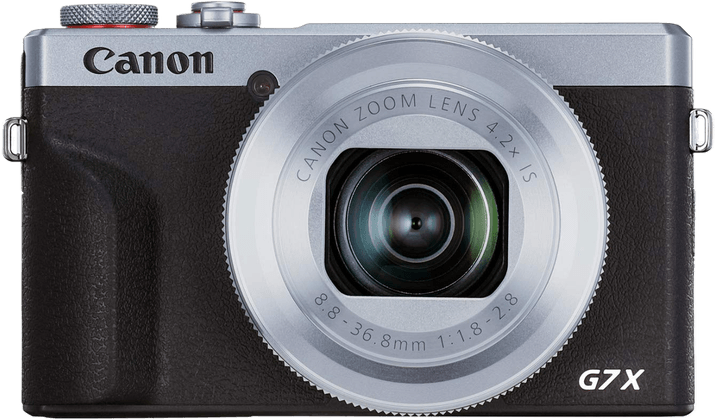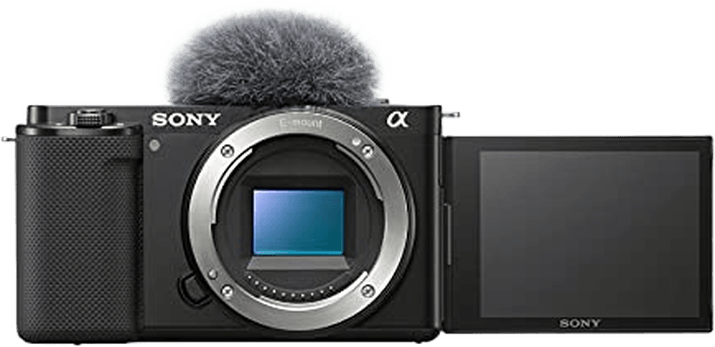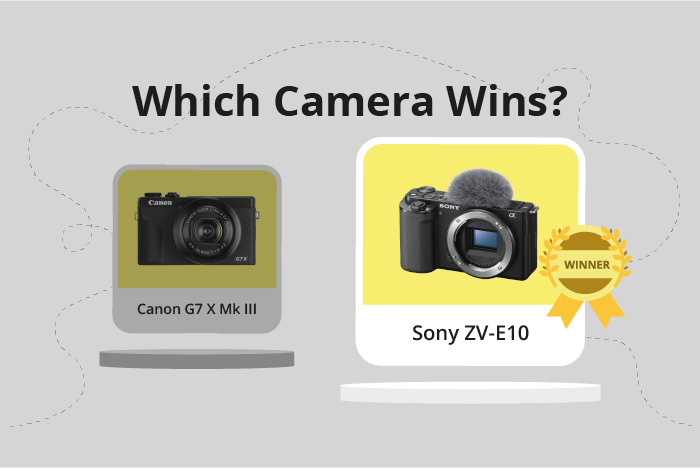Canon PowerShot G7 X Mark III vs Sony ZV-E10 Comparison
Canon PowerShot G7 X Mark III

Sony ZV-E10

The Sony ZV-E10 emerges as the winner with a score of 65/100, while the Canon PowerShot G7 X Mark III trails behind at 59/100. Both cameras have a few common specifications, including their release years (2019 and 2021) and their respective launch prices ($749 for Canon and $700 for Sony).
The Sony ZV-E10 outshines the Canon with its mirrorless design, which generally offers better image quality and performance. Moreover, the Sony camera is newer, which might provide more advanced features and technology. On the other hand, the Canon PowerShot G7 X Mark III has a compact design, making it lighter at 304g compared to Sony’s 343g, which could offer better portability for some users.
Taking all these factors into consideration, the Sony ZV-E10 stands as the better option due to its higher score, mirrorless design, and newer release. However, the Canon PowerShot G7 X Mark III might still appeal to users who prioritize a lightweight, compact camera for on-the-go photography.
Canon PowerShot G7 X Mark III vs Sony ZV-E10 Overview and Optics
The Sony ZV-E10 takes the lead in optics with a score of 69/100, while the Canon PowerShot G7 X Mark III falls behind with a score of 57/100. Both cameras share some common specifications, including 20 and 24 megapixels, CMOS sensor type, and shooting speeds of 30 and 11 frames per second (fps) for the Canon and Sony, respectively. Additionally, they both have different processors: the Canon uses a Digic 8, while the Sony employs a Bionz X processor.
The Sony ZV-E10 outperforms the Canon in several areas. It has a higher DXOMARK sensor score of 86 compared to Canon’s 58, indicating better image quality. Moreover, the Sony camera has a larger sensor size (APS-C) than the Canon (1″), which contributes to improved low-light performance and dynamic range. The Sony ZV-E10 also features a Sony E lens mount, providing users with the flexibility to change lenses, unlike the Canon G7 X Mark III with its fixed lens mount.
On the other hand, the Canon PowerShot G7 X Mark III has a faster shooting speed of 30 fps, compared to the Sony’s 11 fps, which may be beneficial for capturing fast-moving subjects. Furthermore, the Canon camera offers image stabilization, while the Sony ZV-E10 does not. Lastly, the Canon has a 3:2 aspect ratio, which is more common for still photography, while the Sony’s 4:3 aspect ratio is less popular.
Taking all factors into account, the Sony ZV-E10 emerges as the superior camera in terms of optics, with a higher score, better sensor performance, and lens flexibility. However, the Canon PowerShot G7 X Mark III offers some advantages, such as faster shooting speed and image stabilization, which may appeal to specific users depending on their photography needs.
Canon PowerShot G7 X Mark III vs Sony ZV-E10 Video Performance
The Canon PowerShot G7 X Mark III and the Sony ZV-E10 both score an impressive 91/100 in video capabilities, showcasing their strong performance in this category. Both cameras offer 4K video resolution, with the G7 X Mark III providing 3840 x 2160 dimensions and the ZV-E10 slightly lower at 3840 x 1920. Additionally, both cameras have a maximum video frame rate of 120fps and built-in time-lapse functionality.
The Canon PowerShot G7 X Mark III edges out the Sony ZV-E10 in terms of video dimensions. The G7 X Mark III’s dimensions of 3840 x 2160 allow for slightly more detail in video recordings compared to the ZV-E10’s 3840 x 1920 dimensions. This difference, however, is small and may not be significant for most users.
The Sony ZV-E10, on the other hand, does not have any clear advantages over the G7 X Mark III in video capabilities. Both cameras share the same score, video resolution, and frame rate, with the only differing factor being the slightly smaller video dimensions. This means that the ZV-E10 performs on par with the G7 X Mark III in most aspects of video recording.
In comparing the Canon PowerShot G7 X Mark III and the Sony ZV-E10, both cameras excel in video capabilities, with the G7 X Mark III having a slight advantage in video dimensions. However, this difference is minimal and may not affect the overall video recording experience for most users. Ultimately, both cameras provide strong video performance, making either a suitable choice for individuals seeking high-quality video recording.
Canon PowerShot G7 X Mark III vs Sony ZV-E10 Features and Benefits
The Canon PowerShot G7 X Mark III wins with a feature score of 70/100, while the Sony ZV-E10 scores 68/100. Both cameras share several common specifications. They have a 3-inch screen, touchscreen capabilities, a flip screen, GPS, WIFI, and Bluetooth connectivity.
The Canon PowerShot G7 X Mark III outperforms the Sony ZV-E10 with its higher screen resolution of 1,040,000 dots, compared to the Sony’s 920,000 dots. This difference provides a clearer and sharper display on the Canon camera, enhancing the user experience during shooting and playback.
On the other hand, the Sony ZV-E10 does not have any significant advantages over the Canon PowerShot G7 X Mark III based on the given specifications. The two-point difference in their feature scores is solely due to the Canon’s higher screen resolution.
Considering the similarities and differences in their features, the Canon PowerShot G7 X Mark III is the better camera of the two. The higher screen resolution offers a more enjoyable user experience, making it a more appealing choice for photographers and videographers. The Sony ZV-E10, while not necessarily worse in any aspect, fails to provide any notable advantages over the Canon model. Therefore, the Canon PowerShot G7 X Mark III is the recommended camera for those seeking better display quality in their shooting experience.
Canon PowerShot G7 X Mark III vs Sony ZV-E10 Storage and Battery
The Canon PowerShot G7 X Mark III wins in the storage and battery category with a score of 27/100, while the Sony ZV-E10 scores 24/100. Both cameras have one memory card slot and accept SD, SDHC, and SDXC cards. The Canon G7 X Mark III is compatible with UHS-I cards, while the Sony ZV-E10 also accepts Memory Stick Pro Duo cards.
The Canon G7 X Mark III has a battery life of 235 shots, which is significantly lower than the Sony ZV-E10’s 440 shots. However, the G7 X Mark III uses the NB-13L battery and supports USB charging, providing more convenience for on-the-go photographers.
Despite its lower score, the Sony ZV-E10 has a longer battery life using the NP-FW50 battery, which could be beneficial for extended shooting sessions. However, it lacks USB charging, making it less convenient for users who need to recharge their camera frequently.
Considering the storage and battery aspects, the Canon PowerShot G7 X Mark III offers better compatibility with UHS-I cards and USB charging, while the Sony ZV-E10 provides longer battery life but lacks USB charging support.
Canon PowerShot G7 X Mark III vs Sony ZV-E10 – Our Verdict
Are you still undecided about which camera is right for you? Have a look at these popular comparisons that feature the Canon PowerShot G7 X Mark III or the Sony ZV-E10:

